Unearthing ESG in the Gold Industry
March 07, 2022
Read Time 13 MIN
Socially responsible, sustainable, and environmental, social and governance (“ESG”), are all themes that are being incorporated into investment decisions by many funds around the world. In fact, there are now funds that invest solely on ESG performance. As the sustainability movement has gained momentum over the past several years, we have found ourselves wondering what all the fuss was about. The gold industry has learned the hard way over the years that shareholders are not the only stakeholders who should benefit from a gold mine. Other stakeholders who are equally important include employees and their families, local communities or tribes, state/provincial and national governments, and the environment. Failure to treat all stakeholders fairly can hamper or even shut down an operation, with loss of jobs and income for all.
Unfortunately, the image much of the investing public has of mining continues to come from accounts of artisanal or small-scale mining, headline disasters, and historic and outdated mining practices. Here, we discuss each of these in detail, along with further sustainability efforts:
Artisanal Mining— Artisanal and small-scale mining (ASM) have become a problem in many countries where it causes losses in tax revenue, crime, and pollution. Most ASM is illegal, so the gold is traded on the black market. According to Delve, a global platform for artisanal and small scale mining data funded by the World Bank, the total workforce associated with ASM mining is estimated to be roughly 45 million people across 80 countries.1
For many it is their means of income so the fact that it is illegal, however, has not stopped a rise in ASM production over the past several years. The increase is due to a gold price that has tripled since 2006, population growth, lack of economic opportunities, and cell phone technologies that facilitate communications and payments. Countries with limited means find ASM difficult to monitor or regulate. Artisanal camps can spring up overnight once gold is discovered. Metals Focus, a consultancy focused on the metals and mining industry, stated in late 2020 that the expected increased gold price in 2021 would lead to a projected production increase of roughly 13% from ASM.2 Due to its secretive nature and illegality, detailed production figures are difficult to ascertain but estimates from many sources across the industry indicate that output from ASM and other similar sources could account for roughly 20% of global gold production.
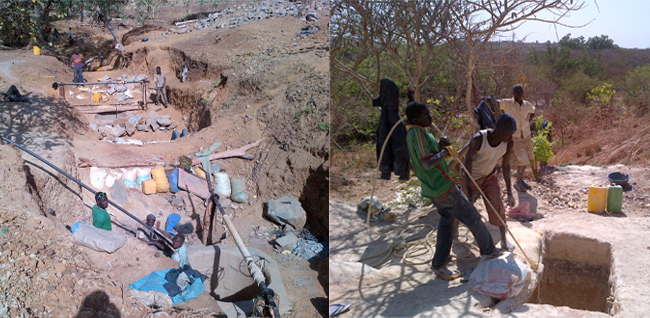
Artisanal mining, Burkina Faso (Source: VanEck, 2014)
These photos show typical African artisanal operations, with men and sometimes women or children working to earn a living for their families, often at better wages than in traditional trades.
ASM is also prevalent in South America and is now widespread and lucrative enough to attract the attention of criminal enterprises. Cartels, gangs, militias, and terrorists are increasingly exploiting ASM to fund their activities.
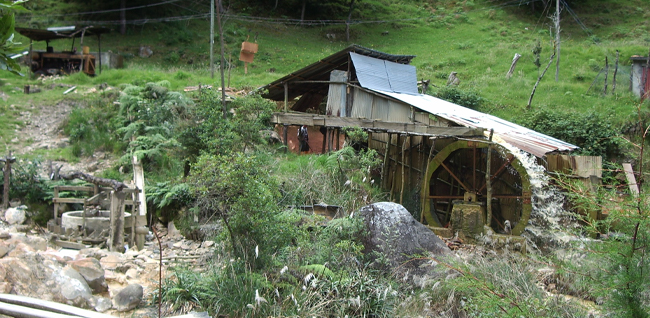
ASM operations use gravity to separate coarse gold from the ores. Pure gravity separation is environmentally benign, however, this is often followed by chemical solution to extract fine-grained gold. This requires the use of mercury or cyanide that is subsequently discarded into the environment.
Modern commercial gold mining and the companies in which we invest have nothing to do with ASM mining. Most ASM deposits are too small to be of interest to a commercial operation. However, companies sometimes discover an economic deposit in an area of ASM mining. In such cases, the mining company is usually able to clean up the environmental damage and become a place of legal employment for many ASM miners. In addition, with the assistance of national police or military, organized crime can be driven out.
Headline Disasters—The failure, in particular, of a tailings dam at an iron ore mine in Minas Gerais, Brazil made global headlines in 2019. Not least because of the loss of life. Like any industrial activity, mining has risks that can result in damage, injury, or death. Lost in the rage of disaster is the fact that there are thousands of tailings facilities around the world that have been properly designed and constructed. Gold mines tend to be smaller and without the massive facilities needed by iron or copper mines. Hopefully the Brazilian tragedy brings a new focus among mining companies that makes tailings failures obsolete.
Underground coal mines also make headlines due to health and mining risks that are unique to coal deposits. Ground control and ventilation are more manageable in underground gold mines than with coal for many reasons (not least of which being relative rock strength). In my career, I honestly cannot remember any catastrophic environmental or health failures in the gold mining industry. Unfortunately, the image of all miners suffers when one fails.
Historic Mining—Many of the superfund3 sites in the U.S. are abandoned pre-World War ll mining operations that destroyed the landscape and left acid-generating waste piles and mine workings to pollute waterways with toxic metals. This is the image of mining that environmental extremists and anti-mining NGOs portray to the public. However, the regulatory framework now in place globally makes it virtually impossible to construct an operation that would do such damage. Companies undertake a tremendous amount of drilling, testing, engineering, and metallurgical work that results in life-of-mine plans that return the landscape to as close to its original state as possible. This before and after photo is a reclaimed Newmont (7.7% of net assets as of 1/31/2022) gold mine in Indonesia. Notice that the process facilities, buildings, and other infrastructure are removed for sale or recycling. The roads and dumps are contoured to match the topography. Finally, topsoil stockpiled for closure is spread and the area is reseeded with native vegetation.
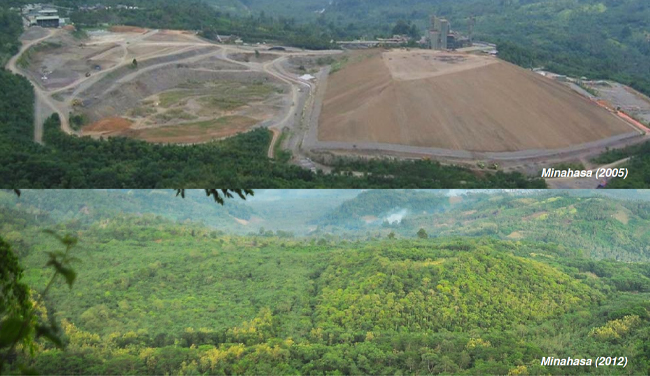
Minahasa mine waste dump and plant area, Indonesia (Source: Newmont, 2018)
Sometimes historic mining properties are found to contain economic deposits either under current market conditions or with additional drilling. In such cases, a company can incorporate remediation into its life-of-mine plans. Over the past several years, there have been excellent examples of this. Junior developer Perpetua Resources (formerly Midas Gold), following submission of plans to the U.S. Forest Services to redevelop its Stibnite mine in Idaho, intends not only properly to dispose of historic tailings and restore salmon runs ruined by mining, but also to supplying a portion of the antimony it mines to help power the Ambri high-capacity storage battery.
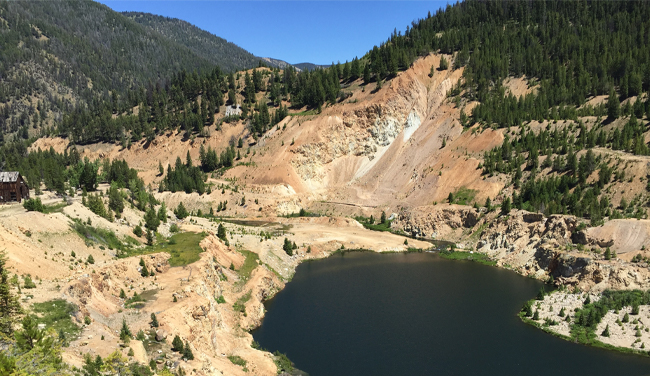
Historic Stibnite Mine, Idaho (Source: VanEck, 2016)
Social Responsibility—Gold companies tend to operate in remote corners of the planet. They are good at mining, but not so good at media relations. Far from the glare of mainstream media, their untold story is the positive impact on the communities and countries in which they operate, in our view. We have been incorporating environmental and social issues in our investment process since long before responsible, sustainable and ESG became buzzwords. Our evaluation includes visiting sites to see activities. Employment opportunities, infrastructure improvement, and better health and education are some of the benefits mining operations provide. For example, at its Kibali mine in eastern Democratic Republic of Congo (“DRC”), Barrick Gold (then Randgold) had a relocation program that moved people from mud huts to concrete housing with a kitchen area, toilet, electricity, and a clean reliable water source. While it may not seem like much to Western eyes, this is activity that transforms the lives of a community.
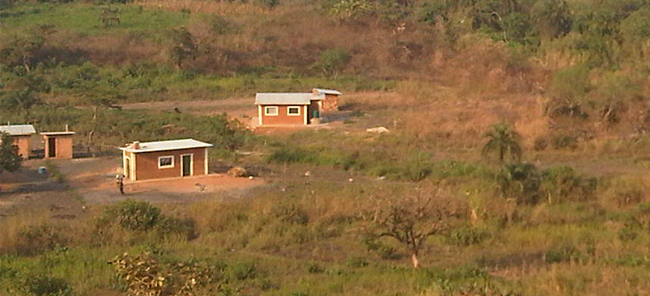
Kibali mine area housing, Democratic Republic of Congo (Source: VanEck, 2012)
Gold mines do not last forever, so some companies attempt to establish sustainable employment once the mine shuts down. For example, junior producer Golden Star Resources (since acquired by Chifeng Jilong Gold Mining in early-2022) initiated a number of entrepreneurial business efforts near its operations in Ghana. It observed that eggs were trucked into the area every day and so taught egg farming skills to local residents. It also experimented with pig farming and possibly fish farming in lakes of abandoned open pit mines. The company found palm trees grow very well on old tailings sites. The trees in the photo below will soon begin (or have already started!) bearing fruit for palm oil production. This, along with plantations on land provided by the local chief, currently employs in the 100s.
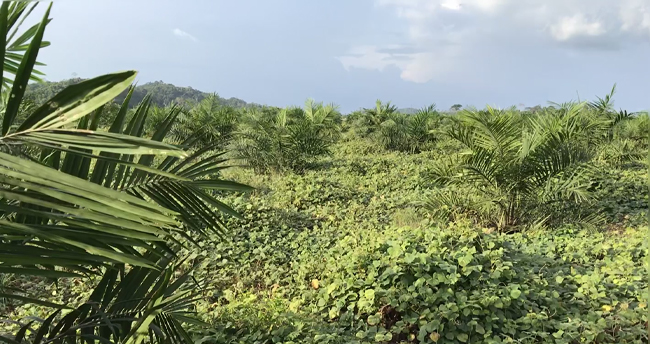
Reclaimed Golden Star mine tailings facility, Ghana (Source: VanEck, 2018)
These are just a few examples of gold company activities that we find compelling. Technological advances are also enabling some mines to convert energy needs to solar, wind, or natural gas when economically feasible. There are also broad efforts to reduce fresh water use and greenhouse gas emissions.
Miners Improve ESG Reporting Though GHG Challenges Exist
Simply because of the nature of their business, gold mining companies can be exposed to high environmental, social or governance risks.
Unfortunately, historically, managements have done a poor job of reporting on either their ESG activities or accomplishments to the public. That is rapidly changing as ESG gains equal time to operations and finance in reports, meetings and calls with investors. Company websites now have entire sections on sustainability, while the quantity and quality of information they provide is improving. At VanEck, we invest in companies that, we believe, do an excellent job of managing social issues, water, tailings, reclamation, safety and health.
In our view, the most challenging aspect of ESG for mining companies is greenhouse gas (“GHG”) emissions. The Paris Agreement has become the accepted standard, calling for net-zero GHG emissions by 2050. While such a goal will be a monumental challenge for all mining companies, we see some being less challenged than others. GHG emissions are measured in millions of tonnes of carbon dioxide (MtCO2) and classified as Scope 1 (direct—mainly from mine equipment), Scope 2 (indirect—mainly from the power grid) and Scope 3 (value chain—downstream from the mine). Jeffries Equity Research found 2019 Scope 1 and 2 emissions across 18 large mining companies totaled 192.6 MtCO2, while Scope 3 totaled 2,467.3 MtCO2. Companies involved in iron ore, bauxite (raw aluminum) and coal carry much higher Scope 3 emissions. In the following table, we compare GHG emissions of Newmont, the largest gold company, with BHP Billiton, the largest diversified miner:
| Market Cap | Scope 1 | Scope 2 | Scope 3 | Total (MtCO2) | |
| BHP Billiton (BHP) | 184 | 10 | 6 | 402 | 418 |
| Newmont (NEM) | 55 | 2 | 2 | 5 | 9 |
| BHP/NEM | 3.3x | 6.3x | 3.2x | 78.8x | 48.9x |
Source: Company Data, Jeffries Equity Research, Bloomberg, VanEck. Most recent data available as of February 2022.
The table shows that some miners are clearly in another league when it comes to emissions challenges.
ESG Integration Among Companies Remains A Work in Progress
Amongst the gold miners, Newmont took the lead when, in November 2020, the company announced climate targets of a 30% reduction in GHG emissions by 2030 and a goal of net zero carbon emissions by 2050. We conduct ESG meetings with all of the producers in our portfolio and find all now have targets that are similar to Newmont’s. However, beyond their 2030 goals, we do find strategies that are lacking in detail. The wave of ESG investing has happened too quickly for most heavy industries to get a grip on what exactly net-zero emissions will entail. It remains a work in progress. According to a Wood Mackenzie study of 31 major gold mining companies published by the World Gold Council, around 95% of emissions are associated with purchased power or fuel combustion. This means that the miners will rely heavily on power companies and equipment suppliers to meet their goals.
Power Consumption—Based on the current status and known plans of the gold mining industry, Wood Mackenzie finds that the emissions intensity of power used in gold production is estimated to fall by 35% by 2030 as follows:
- The grid power mix of gold producing countries is expected to reduce coal usage from 25% to 18%, while increasing solar and wind from 7% to 19%.
- Some companies plan to install solar facilities at mines where feasible, although this represents just 12% of the mines in the study.
- A range of small scale efficiency initiatives, such as automation, big data and ore sorting will help.
- Some companies have high emissions mines that will scale down or close by 2030.
We regard this as the low hanging fruit. Advancements in technology and lower costs for batteries and renewable energy will be needed in order for power consumption to reach net zero by 2050.
Heavy Equipment—The other major sources of GHG emissions are diesel-powered trucks, loaders, dozers and other mine-site equipment. Two of the larger gold companies have underground mines in Ontario, Canada where most of the equipment is electric. Just five years ago, the battery technology did not exist to enable electric underground equipment to operate efficiently. Coupled with hydro-electric grid power, the carbon footprint is relatively small. These two mines are on the cutting edge of a trend toward electrification of underground mines that we expect to see in the coming decade.
Open pit mines present a bigger challenge than underground mines because they run such massive equipment. Two years ago the International Council on Mining and Metals (ICMM) announced an initiative backed by 27 of the world’s biggest miners and 18 original equipment manufacturers (OEMs) to have GHG-free open pit mining vehicles used widely by 2040. ICMM members have reviewed over 650 mines to assess what’s needed to reach the program’s goals and they will look to integrate the initiative into corporate planning processes. An example of this progress more recently was evident when Newmont Corporation announced in November 2021 that the company has entered into a strategic alliance with Caterpillar. This partnership seeks to transform mining by delivering a fully connected, automated, zero carbon emitting, end-to-end mining system. A fleet of 26 electric vehicles is expected to be deployed in underground and open pit operations by 2027, would should support Newmont’s net zero carbon goal by 2050.
The gold industry has recognized the need for rigor and standardization in ESG reporting. To accomplish this, in 2019 the industry-backed WGC published Responsible Gold Mining Principles (“RGMP”). The RGMP sets ten ESG principles containing 51 items for companies to report on. The principles are a synthesis of a number of global standards already in use, as well as input from a range of stakeholders and agencies. They are aimed at providing investors and consumers with confidence that gold is ethically sourced. Conformance with the principles will be insured annually through public reporting and a third-party “independent assurance” conducted at both the mine site and corporate level. Companies that participate will be allowed a three-year period of implementation, with independent assurance beginning in the third year. We expect all of the gold producers in which we invest to adopt RGMP.
The WGC has also set a lofty goal of net-zero emissions by 2050 through process enhancement, decarbonization of transport and electricity, self-sufficient energy and emissions off-sets. While the industry is already reducing emissions where it makes the most economic sense, in our opinion, meeting the 2050 goal will require further technical advances in renewable energy, battery storage and electric vehicles that are beyond the gold industry’s control. Companies stand ready to test and adopt new technologies, but we believe widespread implementation is years from becoming reality.
Conclusion
Managing environmental and social risk is nothing new to gold companies. In fact, it is among the most important aspects of their business. We do not invest in companies that fail to strive for ESG excellence. However, if investors avoid the broader mining industry due to what we see as unrealistic or misguided ESG expectations, the industry may become starved of the capital needed to maintain production. If taken to extreme, we believe a lack of capital creates shortages and rising prices that could bring an unwanted inflationary cycle with world-wide economic hardship.
To receive more Gold Investing insights, sign up in our subscription center.
Follow Us
IMPORTANT DISCLOSURE
1 https://delvedatabase.org. 2020 State of the ASM Sector Report.
2 https://www.bullionvault.com/gold-news/gold-mining-2021-101520201.
3 Superfund sites are polluted locations requiring a long-term response to clean up hazardous material contaminations.
Nothing in this content should be considered a solicitation to buy or an offer to sell shares of any investment in any jurisdiction where the offer or solicitation would be unlawful under the securities laws of such jurisdiction, nor is it intended as investment, tax, financial, or legal advice. Investors should seek such professional advice for their particular situation and jurisdiction.
Any indices listed are unmanaged indices and include the reinvestment of all dividends, but do not reflect the payment of transaction costs, advisory fees or expenses that are associated with an investment in a Fund. Certain indices may take into account withholding taxes. An index’s performance is not illustrative of a Fund’s performance. Indices are not securities in which investments can be made.
Please note that the information herein represents the opinion of the author, but not necessarily those of VanEck, and this opinion may change at any time and from time to time. Non-VanEck proprietary information contained herein has been obtained from sources believed to be reliable, but not guaranteed. Not intended to be a forecast of future events, a guarantee of future results or investment advice. Historical performance is not indicative of future results. Current data may differ from data quoted. Any graphs shown herein are for illustrative purposes only. No part of this material may be reproduced in any form, or referred to in any other publication, without express written permission of VanEck.
About VanEck International Investors Gold Fund (INIVX): You can lose money by investing in the Fund. Any investment in the Fund should be part of an overall investment program, not a complete program. The Fund is subject to the risks associated with concentrating its assets in the gold industry, which can be significantly affected by international economic, monetary and political developments. The Fund’s overall portfolio may decline in value due to developments specific to the gold industry. The Fund’s investments in foreign securities involve risks related to adverse political and economic developments unique to a country or a region, currency fluctuations or controls, and the possibility of arbitrary action by foreign governments, or political, economic or social instability. The Fund is subject to risks associated with investments in Canadian issuers, commodities and commodity-linked derivatives, commodities and commodity-linked derivatives tax, gold-mining industry, derivatives, emerging market securities, ESG investing, direct investments, foreign currency transactions, foreign securities, other investment companies, management, market, non-diversification, operational, regulatory, small- and medium-capitalization companies and subsidiary risks.
Diversification does not assure a profit or protect against loss.
ESG investing is qualitative and subjective by nature, and there is no guarantee that the factors utilized by VanEck or any judgment exercised by VanEck will reflect the opinions of any particular investor. Information regarding responsible practices is obtained through voluntary or third-party reporting, which may not be accurate or complete, and VanEck is dependent on such information to evaluate a company’s commitment to, or implementation of, responsible practices. Socially responsible norms differ by region. There is no assurance that the socially responsible investing strategy and techniques employed will be successful.
ESG integration is the practice of incorporating material environmental, social and governance (ESG) information or insights alongside traditional measures into the investment decision process to improve long term financial outcomes of portfolios. Unless otherwise stated within the Fund’s investment objective, inclusion of this statement does not imply that the Fund has an ESG-aligned investment objective, but rather describes how ESG information is integrated into the overall investment process.
Please call 800.826.2333 or visit vaneck.com for performance information current to the most recent month end and for a free prospectus and summary prospectus. An investor should consider a Fund's investment objective, risks, charges and expenses carefully before investing. The prospectus and summary prospectus contain this as well as other information. Please read them carefully before investing.
Related Funds
IMPORTANT DISCLOSURE
1 https://delvedatabase.org. 2020 State of the ASM Sector Report.
2 https://www.bullionvault.com/gold-news/gold-mining-2021-101520201.
3 Superfund sites are polluted locations requiring a long-term response to clean up hazardous material contaminations.
Nothing in this content should be considered a solicitation to buy or an offer to sell shares of any investment in any jurisdiction where the offer or solicitation would be unlawful under the securities laws of such jurisdiction, nor is it intended as investment, tax, financial, or legal advice. Investors should seek such professional advice for their particular situation and jurisdiction.
Any indices listed are unmanaged indices and include the reinvestment of all dividends, but do not reflect the payment of transaction costs, advisory fees or expenses that are associated with an investment in a Fund. Certain indices may take into account withholding taxes. An index’s performance is not illustrative of a Fund’s performance. Indices are not securities in which investments can be made.
Please note that the information herein represents the opinion of the author, but not necessarily those of VanEck, and this opinion may change at any time and from time to time. Non-VanEck proprietary information contained herein has been obtained from sources believed to be reliable, but not guaranteed. Not intended to be a forecast of future events, a guarantee of future results or investment advice. Historical performance is not indicative of future results. Current data may differ from data quoted. Any graphs shown herein are for illustrative purposes only. No part of this material may be reproduced in any form, or referred to in any other publication, without express written permission of VanEck.
About VanEck International Investors Gold Fund (INIVX): You can lose money by investing in the Fund. Any investment in the Fund should be part of an overall investment program, not a complete program. The Fund is subject to the risks associated with concentrating its assets in the gold industry, which can be significantly affected by international economic, monetary and political developments. The Fund’s overall portfolio may decline in value due to developments specific to the gold industry. The Fund’s investments in foreign securities involve risks related to adverse political and economic developments unique to a country or a region, currency fluctuations or controls, and the possibility of arbitrary action by foreign governments, or political, economic or social instability. The Fund is subject to risks associated with investments in Canadian issuers, commodities and commodity-linked derivatives, commodities and commodity-linked derivatives tax, gold-mining industry, derivatives, emerging market securities, ESG investing, direct investments, foreign currency transactions, foreign securities, other investment companies, management, market, non-diversification, operational, regulatory, small- and medium-capitalization companies and subsidiary risks.
Diversification does not assure a profit or protect against loss.
ESG investing is qualitative and subjective by nature, and there is no guarantee that the factors utilized by VanEck or any judgment exercised by VanEck will reflect the opinions of any particular investor. Information regarding responsible practices is obtained through voluntary or third-party reporting, which may not be accurate or complete, and VanEck is dependent on such information to evaluate a company’s commitment to, or implementation of, responsible practices. Socially responsible norms differ by region. There is no assurance that the socially responsible investing strategy and techniques employed will be successful.
ESG integration is the practice of incorporating material environmental, social and governance (ESG) information or insights alongside traditional measures into the investment decision process to improve long term financial outcomes of portfolios. Unless otherwise stated within the Fund’s investment objective, inclusion of this statement does not imply that the Fund has an ESG-aligned investment objective, but rather describes how ESG information is integrated into the overall investment process.
Please call 800.826.2333 or visit vaneck.com for performance information current to the most recent month end and for a free prospectus and summary prospectus. An investor should consider a Fund's investment objective, risks, charges and expenses carefully before investing. The prospectus and summary prospectus contain this as well as other information. Please read them carefully before investing.